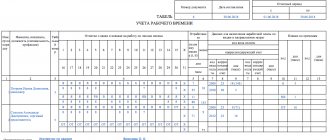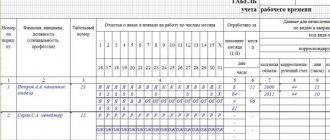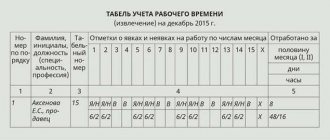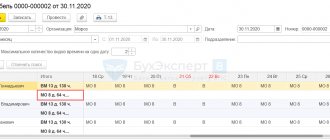Regulatory justification
In the process of studying the rules for recording working hours, we will repeatedly turn to the following regulatory legal acts:
- Labor Code of the Russian Federation (hereinafter referred to as the Labor Code of the Russian Federation);
— Federal Law No. 402-FZ dated December 6, 2011 “On Accounting” (hereinafter referred to as Law No. 402-FZ);
— Resolution of the State Statistics Committee of the Russian Federation No. 1 of January 1, 2004 “On approval of unified forms of primary accounting documentation for recording labor and its payment” (hereinafter referred to as Resolution of the State Statistics Committee No. 1).
From January 1, 2013, it is not necessary to use unified forms. The organization has the right to develop time sheets, shift schedules, personnel orders and other documents independently. But experience shows that the forms proposed by the State Statistics Committee are most often used.
Why you can’t refuse to keep a time sheet
Even if your organization has installed the second version of “pass” software and you have the opportunity to use it to track working time, you cannot refuse to keep timesheets on paper. The employer is obliged to keep records of the time actually worked by each employee1. For these purposes, unified forms of time sheets N T-12 and T-132 have been approved. And it is better to keep them in order to avoid problems during inspections by the labor inspectorate3. More advanced electronic systems allow you to generate time sheets according to forms N T-12 and T-13. But you still need to print it out and sign it every month.
Operating mode
The concept of working hours includes the procedure for distributing the standard working hours of an employee in a particular organization during a certain period (day, week, month). And here there are several options:
- irregular working hours;
- flexible working hours;
- shift work;
- dividing the working day into parts, etc.
General provisions for the enterprise are indicated in the collective agreement or in the internal labor regulations; the regime of a specific employee is indicated in his employment contract.
The document that regulates the employee’s work schedule must contain several important points. Firstly, the length of the working week. This could be a standard 5-day work week, floating weekends, work 2 through 2, etc.
No matter how the work week is organized, you must provide employees with mandatory rest days - at least 42 hours in a row (Article 110 of the Labor Code of the Russian Federation). The exception is the rotation method: only 1 day off per week is allowed.
The second important issue is the duration of daily work (shift). In most cases, this is an 8-hour working day, but there are other options, for example, a shortened day for certain categories of employees (minors, disabled people, employees in hazardous and hazardous industries, etc.).
Pay attention to the concept of “irregular working hours”. It does not include working on weekends, holidays or at night. We are talking only about exceeding the normal working hours. This type of employment is paid at the usual rate, but the employee is entitled to additional paid leave for at least 3 days.
Sidebar: Irregular working hours are not recorded on the time sheet. The time sheet indicates the hours of the standard working day, and an indication of the special mode of work and the duration of additional leave is contained in the employment contract.
The documents may reflect the division of the working day into parts, flexible working hours and other options permitted by law.
The employment contract or internal regulations must indicate the start and end times of the working day, the time and duration of rest and lunch breaks (no less than 30 minutes and no more than 2 hours).
How to fill out a time sheet for 2021
When filling out a time sheet, the following conventions are used:
| Name | Code |
| Report to the workplace according to the usual schedule during daylight hours | I |
| Weekends and non-working holidays | IN |
| Night shift | N |
| Carrying out government duties | G |
| Overtime hours | WITH |
| Length of time working on a rotational basis | VM |
| Being on a business trip | TO |
| Absence from work due to assignment to advanced training courses | PC |
| Taking advanced training courses when traveling to another locality | PM |
| Regular annual leave | FROM |
| Duration of additional paid leave | OD |
| Time spent on study leave when combined with work | U |
| Additional unpaid educational leave | UD |
| Working hours for students and workers for whom wages have been partially retained | UV |
| Maternity leave | R |
| Additional leave related to caring for a child under 3 years of age | coolant |
| Unpaid vacation day in agreement with the head of the organization | BEFORE |
| Unpaid vacation day granted in accordance with the law | OZ |
| Additional unpaid leave | DB |
| Time spent on sick leave with corresponding payment of benefits | B |
| Unpaid sick leave | T |
| Half-holiday | Champions League |
| Forced absence from work due to the employer’s dismissal actions being declared illegal or other circumstances with reinstatement to the previous position | PV |
| Absenteeism | ETC |
| Part time | NS |
| Paid days off | OB |
| Unpaid days off | NV |
| Time spent on strike | ZB |
| Absence from work without explanation | NN |
| Cases of downtime due to the fault of the employer | RP |
| Downtime due to employee fault | VP |
| Downtime due to reasons beyond the control of the employee or employer | NP |
| Suspension of work due to delayed payment of wages | NZ |
What is the difference between the T-12 and T-13 forms?
In addition to the T-13 form, the unified T-12 form is used to record working hours. Its difference is that it indicates not only the duration of work and other periods, but also data on accrued wages, and this type of document is filled out manually.
The more common form is T-13, which reflects only the employment of each employee and is filled out electronically; thanks to this, there are many services for automating work.
How are the days of employee participation at a conference or other training events indicated on the T-13 report card?
The manager decides how to count these days. There are two options: either workers, then the code “I” will appear on the report card, or advanced training courses with the code “PC”. But the payment for them may vary.
Is it possible to enter the code “I” when the work shift is more than 8 hours?
This is possible if there is an order from management regarding extended working hours or established irregular work hours. Then, in the first case, overtime hours worked can be marked with code “C”. In the second case, such hours are not designated in any way and are not paid additionally.
This video will help you quickly master this material, which will tell you how to draw up a work time sheet using the unified T-13 form.
The presence of a time sheet allows the accounting department and human resources department of the organization:
- Take into account the hours spent at the workplace by each of the hired workers.
- Monitor compliance with work schedules (attendance/absence, tardiness).
This information helps in calculating wages for each employee and compiling statistics. Having time sheet information, an employee of the personnel department will be able to justify the sanctions imposed on the worker (for example, for being late). And the accountant will explain how legal the payments of compensation and other benefits are.
According to Art. 62 of the Labor Code of the Russian Federation, a worker has the right to request an extract from the employer with his data from the timesheet.
Please note: since January 2013, unified document forms are not mandatory. Although their format is simple and easy to use. At the same time, employers are not relieved of the obligation to maintain these records. This is stated in the Labor Code (Part 4, Article 91). Managers have the right to control employees' working hours in any convenient way.
The established forms of primary accounting papers have instructions for use:
- The generation and maintenance of documentation should only be carried out by an authorized person.
- The paper is presented to the department management and the HR department employee for signature.
- Then the time sheet in excel is transferred to the accounting department employee.
The specific position whose representative is required to fill out the TURV is not provided for by the rules. Any employee can be appointed as a manager.
After selecting the responsible person, an order is prepared or the assigned obligation is recorded in the employment agreement of the selected employee. Otherwise, the employee has the right not to do timesheets.
If the organization has an impressive staff, a responsible person is chosen in each department. TURV is carried out as follows:
- During the billing month, the assigned employee records information about his department.
- Next, the head of the department checks all the data and general design. If there are no errors, he signs the report card and hands it over to the personnel employee.
- HR department employees verify data and record the parameters necessary for their activities. Afterwards, the paper is certified by signature and forwarded to the accounting department.
Small organizations follow a simplified chain. The HR department is supposed to keep the time sheet there.
Time sheet
A human resources specialist or other authorized employee enters data on colleagues’ hours worked and unworked into the primary accounting form - a time sheet. Traditionally, unified form No. T-12 “Sheet for recording working time and calculating wages” or form No. T-13 “Sheet for recording working time” (Resolution of the State Statistics Committee of the Russian Federation No. 1) are used. An organization can develop and approve its own form of time sheet, but in this case the document must contain all the necessary details provided for in Part 2 of Art. 9 of Law No. 402-FZ.
The Kontur-Personnel program automatically maintains a timesheet in accordance with the selected schedule and taking into account all deviations issued by orders for vacations, sick leave, absences, overtime, etc.
To learn more
To fill out the report card, Goskomstat has provided a system of symbols. But you have the right to develop your own. Moreover, the list proposed by the department does not take into account all possible employment options for employees. For example, there are no symbols to reflect work at night on a shift or on weekends on a business trip.
Filling out the timesheet can be organized in different ways:
- registration of deviations (no-shows, overtime hours worked, delays, etc.);
- continuous recording of all appearances and absences.
For companies with a small number of employees and standard working hours, it is convenient to record only deviations. If the enterprise has a large number of employees with different work schedules, it is advisable to use continuous registration.
Top 10 best time tracking and employee monitoring systems in 2021
Application prices vary. In most cases, the price depends on the number of users who will be monitored. The more users, the higher the cost may be, but there are discounts for larger organizations. Tools like InterGuard and Veriato 360 have additional modules with advanced functionality. If you want an app with a one-time purchase instead of a monthly or yearly subscription, StaffCop Enterprise and Work Examiner offer per-user licenses. True, the installation is carried out locally on the organization’s computers.
According to the rules for filling out the 2021 working time sheet, information about employees’ attendances and absences is indicated using codes. The design rules are such that these codes must be adhered to. By the way, the title page of form No. T-12 shows the alphabetic and numerical designations used in the time sheet.
Table: designations in the time sheet in 2021
Functionally, the time sheet is required for the following purposes:
- control of personnel regarding attendance and absence from work (as well as their reasons);
- analysis of the actual employment of each employee;
- calculation of processing;
- calculation of wages and other payments depending on the actual time worked;
- evidence in case of labor disputes;
- grounds for dismissal in case of absenteeism;
- for reporting to control authorities.
Each organization has the right to maintain time sheets in one of the ways, which is chosen regardless of the operating mode used:
- continuous order with registration of attendances and absences at the workplace;
- recording only deviations in the form of overtime working hours, absences, etc.
It is necessary to use the continuous registration accounting method when working on a shift schedule, when it is necessary to summarize the hours worked for different days. This way you can identify cases of overtime at work.
And then analyze them and adjust them in such a way as to subsequently minimize the involvement of workers beyond the established working hours.
The second method is most optimal for organizations where the working day is a constant number of hours. Then only deviations are indicated in the report card.
When filling out the document, you should apply the standards prescribed in the Instructions approved by Resolution of the State Statistics Committee of January 5, 2004 No. 1. They are subject to the maintenance of all documents related to the accounting of labor time and its payment.
To record working time, a unified form T-13 . It is filled out in a single copy.
Daily and summarized working time recording
To record working time, the accountant has the right to choose one of the methods depending on the characteristics of the organization of work at the enterprise: daily or summarized recording of working time. The first method is suitable for small organizations with a normal work schedule: a 5-day week with an 8-hour working day.
Keeping summarized records of working time is considered more labor-intensive. It is used when it is difficult to comply with the daily, weekly, monthly working hours corresponding to the normal working hours according to the production calendar (Article 100 of the Labor Code of the Russian Federation). When implementing summarized working time recording in an organization, registration of attendance/absenteeism in the working time sheet is carried out using a continuous method.
With summarized accounting, the indicators of actual time worked per month/week/day, as a rule, differ from the norms established by the production calendar. The employer is obliged to establish an accounting period: month, quarter, half-year or year, at the end of which the actual time worked must coincide with the standard working time according to the production calendar. Overtime during some time periods of the accounting period must be compensated for by shortcomings during other time periods.
Example. Security guard, working hours: every other day. For this employee, a summarized recording of working time with an accounting period of a quarter is used. In January, due to the security guard working shifts on holidays and weekends, the actual time worked exceeded the production calendar norm. In February the figures coincided. In March, the HR specialist must draw up a work schedule for this employee in such a way that, at the end of the quarter, the actual time worked coincides with the norm according to the production calendar.
How to correctly fill out a time sheet: sample and recommendations
Let's start with the T-13 form, which is now used much more often for maintaining time sheets.
The unified form T-13 or electronic time sheet is well known to HR department employees. This is not the only way, but it is definitely the most standard way to account for hours worked. If you keep records manually, you should use Form T-12.
Timesheets are a common tool for tracking employee attendance. Form T-13 allows you to record in detail the reasons for absence from work, including student leave during the session, advanced training and several types of disability leave. The period for which the document is completed may be less than 31 days.
A completed T-13 is the basis for calculating wages.
Some enterprises approve a slightly simplified version of the time sheet without detailing the reasons for omissions. Column 4 indicates only 2 codes:
- I am a working day
- N - unworked day.
This method may be inconvenient because it does not record sick leave.
- How to fill out T-13 for employees participating in conferences and other training events?
- Can code I have a value of more than 8 hours?
- What is the difference between report cards T-12 and T-13?
Depends on the position of the enterprise. These days can be counted as working days (I), or as advanced training (PC). Pay rates may also vary.
Yes. Maybe if there is a special order about extended working hours. Overtime hours can be marked with the symbol C.
The first is a manual attendance form. The second is electronic. Many accounting departments today have switched to T-13, since it can be automatically collected using a special program.
First of all, as in any other personnel records document, you first need to enter the details of the organization into the timesheet: its full name indicating the OKPO code (must be taken from the registration documents), organizational and legal status (IP, LLC, CJSC, JSC), as well as the structural unit (department) for which this timesheet is maintained (if necessary).
Then you need to enter the document number for internal document flow in the appropriate column, and also indicate the reporting period that this timesheet takes into account.
This part of the timesheet includes the alphabetic and numeric codes used to fill out the necessary information for employees, as well as their decoding. They must be entered in the main part of the timesheet in order to briefly and clearly reflect the amount of time actually spent by one or another employee at the workplace, as well as the reasons for his absence from work. If HR department specialists need to enter some additional codes into this timesheet form, they can be developed independently and entered into this table.
This section in the timesheet is the main one - it is where working time is kept track of. First, you need to enter the employee’s serial number in the first column of this section, then in the second - his full name (preferably his full name and patronymic to avoid confusion and errors). In the third column you need to insert the employee’s personnel number assigned to him during employment (it is individual and never repeated).
For each employee, the timesheet has two lines - they contain encrypted information about presence or absence at the workplace on each calendar day of the month. In addition, it is necessary to immediately indicate the reason for absence from work, if one has been established.
The reason is indicated in the top line opposite the employee’s full name, and in the bottom line the number of hours actually worked, and if the employee did not appear at the workplace, the bottom cell can be left empty.
The next step is to calculate the total number of hours and days actually worked for two-week periods, and at the end of the table - the result of the calculations for the month.
Shift work mode
We should especially talk about shift work. It raises many questions both during timesheets and when calculating wages. It is advisable to introduce a shift work mode when the duration of the production process exceeds the permissible length of a working day or the equipment at the enterprise operates around the clock.
If an employer hires a new employee, the shift work schedule is already specified in the employment contract. However, if there is a need to transfer all or several previously hired employees to work in shift mode, several procedures must be followed:
- Issue an order to change the operating mode for the enterprise as a whole or for individual employees.
- Reflect this change in the Internal Labor Regulations or the collective agreement (Part 1, Article 100 of the Labor Code of the Russian Federation).
- Create shift schedules. There is no unified form of the schedule, so each organization develops it independently and approves it with accounting policies. The work schedule is a mandatory document for shift work. It can be approved as a separate form or made an annex to a local regulatory act.
- Write down changes in the additional agreement to the employment contract. The working hours are mandatory conditions, which means that the employer must notify the employee 2 months in advance and obtain his consent. If an employee refuses to work under changed conditions, he should be offered a different position with the same schedule. If an employee does not agree to work under new conditions, the employment contract may be terminated due to refusal to work under new conditions (Clause 7, Part 1, Article of the Labor Code of the Russian Federation).
- Familiarize employees with the shift work schedule no later than one month in advance.
When drawing up a shift schedule, it is necessary to take into account restrictions on the length of the working day for certain categories of citizens and on holidays.
Access system data as confirmation of lateness or absenteeism
Even if you do not have the opportunity to use an electronic access system as a working time recording system, this does not mean that it cannot be used to organize control over labor discipline.
There are many decisions when the court takes into account printouts from a regular electronic access system as evidence of lateness or absenteeism4. In one dispute, an employee tried to prove that information from an electronic checkpoint in the form of computer printouts cannot serve as evidence of being late or leaving work early. The judges indicated that such printouts are written evidence and should be taken into account when resolving the dispute5. But in order for the data of the electronic access system to have weight in court, it is important to fix its use in the local regulations of the organization. Otherwise, the court may not accept such data as evidence6.
After all, it is local regulations that determine the rules of conduct that are mandatory for employees. In particular, the internal labor regulations regulate the work and rest schedule7. Therefore, you can provide in them that:
- Entry to and exit from the territory of the organization is carried out using personal electronic cards;
- the time of such entry and exit, recorded by the system, is taken into account in order to monitor employees’ compliance with the work schedule;
- transfer of the pass to third parties is not permitted.
At the same time, it is also important to regulate the employee’s actions in case he forgot or lost his electronic pass.
We advise the manager
In order to be able to take disciplinary sanctions based on the data from the access system (in particular, for lateness or absenteeism), its use must be recorded in the company’s LNA, for example, in the internal labor regulations.
What control methods are there today?
Traditional approach. In government agencies, there is still the position of a watchman or administrator who keeps a log of working hours, monitors the behavior of employees and sometimes prepares reports for the manager.
Self-control. Employees can independently monitor their working hours and record it in a special form. This helps them evaluate the effectiveness of solving problems and encourages them not to be distracted, especially since management clearly sees the result of the work and the time spent on it using the reporting forms.
Electronic pass system. Helps automate the recording of time of arrival and departure from work, works using passes or fingerprints. Information for each employee is included in the report and is available at any time.
Video surveillance system. An expensive method: you will have to purchase video cameras and hire an employee who will monitor the staff and record violations. In addition, such a system causes discomfort among workers, so cameras are most often installed at critical sites.
Automated IT systems. To control the work of a large company of several hundred people who work remotely or in different offices, automated systems that collect data, analyze it and generate reports are more suitable. In addition, they work for the security of the organization. Management has the opportunity to see the “leading people” of the office and reward them in order to motivate the entire staff. Such systems help to find:
- schedule breakers who are often late or leave early, spend a lot of time on smoking breaks and lunch breaks;
- employees who read news and social media feeds during the day, correspond with friends, play games or solve personal problems;
- overworked workers who work late and are at risk of burnout;
- employees who are dissatisfied with their workplace and are looking for a new job.
Some systems only collect data about employees, others generate reports for the manager and divide employees into risk groups that need special attention. The system will show which departments are wasting more time, and this can be compared with their productivity. When ordering a system, you can determine the “depth of control”: for example, monitor only the time of arrival and departure of an employee, or also record what the employee did at the workplace - usually screenshots are taken for this.









